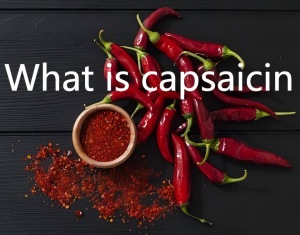What is capsaicin

What is capsaicin? It's the reason your mouth burns when you bite into a hot chili pepper — and also the same compound that's used in muscle creams and pepper sprays. Found naturally in spicy peppers, capsaicin isn't just about heat; it's also full of fascinating benefits and uses that go way beyond food. Let’s dive into the spicy world of this fiery molecule!
Where Does Capsaicin Come From?
Capsaicin is found in chili peppers, especially in the white membrane that holds the seeds. Plants like jalapeños, habaneros, cayenne, and ghost peppers are all rich in this spicy compound. Nature created capsaicin to protect peppers from being eaten by animals—but lucky for us humans, we love the burn!
How Does Capsaicin Work?
The science is spicy, too! Capsaicin activates a receptor in your body called TRPV1, which normally senses heat and pain. When this receptor gets triggered, your brain thinks you're on fire — even though you’re not. That’s why eating hot peppers makes you sweat, cry, and reach for milk.
Health Benefits of Capsaicin
1. Pain Relief
Ironically, the same compound that causes a burning sensation can also relieve pain. Capsaicin is used in topical creams to help with arthritis, nerve pain, and muscle soreness. It works by reducing the amount of a pain transmitter called Substance P.
2. Boosts Metabolism
Feeling the burn? Capsaicin may help with weight loss by slightly increasing your metabolism and encouraging fat oxidation. It might not be magic, but it can give your body a little extra kick.
3. Heart and Circulation Support
Some studies suggest that capsaicin can help improve blood flow and reduce blood pressure. While it’s no substitute for medical treatment, adding a bit of spice to your meals might be good for your heart!
4. Antioxidant Power
Capsaicin contains antioxidant properties that can help combat oxidative stress and inflammation — two factors linked to many chronic diseases.
Common Uses of Capsaicin
In Food
This is where most people meet capsaicin — in hot sauces, spicy dishes, and fiery snacks. From Sriracha to Sichuan cuisine, capsaicin brings the heat to the kitchen.
In Medicine
Capsaicin creams, patches, and even nasal sprays are used for managing chronic pain, cluster headaches, and more. Always follow medical advice when using it in this form.
In Self-Defense
Capsaicin is the active ingredient in pepper spray, a non-lethal self-defense tool. The intense burning sensation it causes is enough to stop most threats in their tracks.
Fun Facts About Capsaicin
- The Scoville Scale measures the heat of peppers — the higher the number, the more capsaicin.
- Birds can eat hot peppers without feeling the burn — they don’t have TRPV1 receptors like mammals.
- Capsaicin is odorless and flavorless — it just feels hot!
Final Thoughts
Capsaicin is more than just a fiery compound — it's a fascinating molecule with real health benefits and a lot of personality. Whether you're a chili lover or just spice-curious, now you know what’s behind that addictive burn. So next time your tongue is on fire, you’ll know it’s all thanks to capsaicin!
